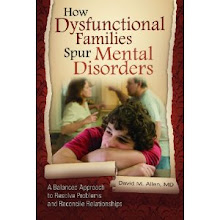One of my complaints about the research literature on the so called “hyper-reactivity” of patients with borderline personality disorder (BPD) is that the authors of such studies almost always look at the quality and frequency of their subjects’ responses without ever looking at what they are responding to. Since mood instability is the most central part of the definition of the disorder, of course they will have more reactions. By definition, they’ve been selected for it!
Two recent studies show that patients with BPD
really don’t seem as different from others as one might expect. They both
provide strong evidence for my point of view. One showed that the specific
reactions to interpersonally threatening stimuli of patients with BPD is not all that different from those of
anybody else. It looked at skin
conductance responses (SCR, a measure of stress) in patients and healthy controls. The second investigated whether or not
patients with other psychiatric disorders responded differently. They found that they all sort of responded the same, in spite of the fact that - once
again - the source and severity of the environmental
events which triggered the patients was ignored.
Here’s some descriptions from the study
abstracts.
1. Hillmann
K; Mancke F; Herpertz SC; Jungkunz M; Olsson A; Haaker J; Bertsch K. Psychopathology. 53(2):84-94, 2020.
Intact Classical Fear Conditioning to Interpersonally Threatening Stimuli in
Borderline Personality Disorder.
Threat hypersensitivity is regarded as a central mechanism of deficient emotion regulation, a core feature of patients with borderline personality disorder (BPD). In this study, patients with BPD showed larger conditioned prolonged conditioned skin conductance responses (SCR) (a measure of stress) and subjective stress and expectancy ratings to interpersonally non-threatening and neutral than interpersonally threatening stimuli, while interpersonally threatening stimuli elicited higher SCR compared to non-threatening or neutral stimuli in healthy controls.
While the overall the results suggest no
alterations in fear conditioning to generally aversive stimuli in BPD, it’s
quite interesting than when someone in the environment is non threatening,
patients with BPD react with MORE stress. One possible explanation: the people
around them most of the time are more likely to attack them when most other people would have let their guard down.
2. Kockler
TD; Santangelo PS; Limberger MF; Bohus M; Ebner-Priemer UW, Specific or
transdiagnostic? The occurrence of emotions and their association with distress
in the daily life of patients with borderline personality disorder compared to
clinical and healthy controls.
Psychiatry
Research 284, 11262, 2020).
The authors wanted to see if hyper-reactivity to stress was specific to BPD or was seen as much in other disorders. Using e-diaries, they compared patients with BPD, normal controls, patients with bulimia, and those with PTSD. The majority of the comparisons (anxiety, sadness, shame, disgust, jealousy, guilt, interest) revealed transdiagnostic patterns, which means that the same reactivity was seen in the other disorders. The only major exception was that patients with BPD exhibited anger more frequently than any of the clinical groups or in healthy control.
As mentioned, nothing was looked at concerning what the anger was about. So maybe anyone would be angry if exposed to whatever it was the patients with BPD had been exposed to.








I may have missed it, but isn’t the intensity of the response relative to the trigger something to be considered?
ReplyDeletePrecisely!
Delete